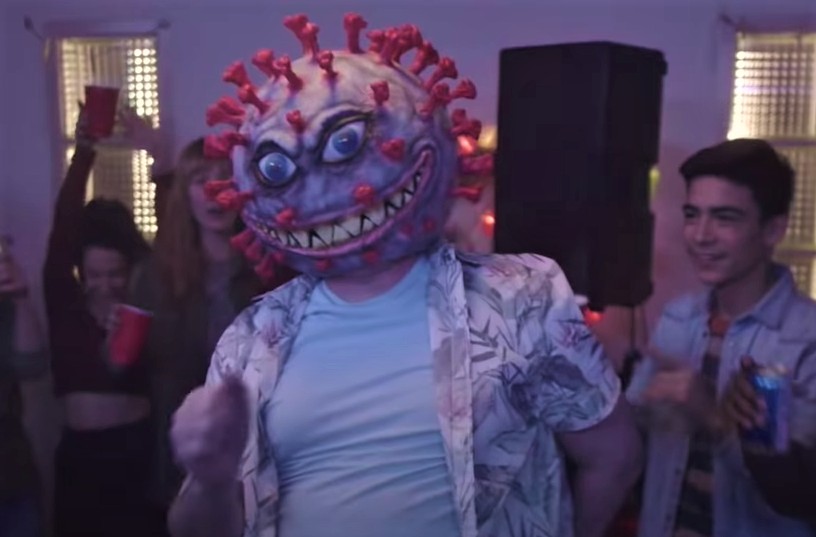
Should gripping pandemic imagery be used to make Ontario care?
Five-hundred-and-sixty-six people have died due to COVID-19 in Peel Region.
How do we comprehend that number? Can you picture that many people in a large room? Would a banquet hall filled for a large wedding represent the number who have died? Do you know any of them? Is one a loved one of yours?
We are nearing a point of serious reckoning over this virus. CEOs of pharmaceutical companies and epidemiologists and public health experts now fear some form of SARS-CoV-2 might be with us forever, like influenza and all its mutated strains.
The difference? While the flu is a deadly killer that takes the lives of 2,000 to 8,000 Canadians each year (according to the Public Health Agency of Canada) – COVID-19 is a much deadlier disease.
The same indifference most have toward the flu (in recent years less than 40 percent of Canadians have received the annual flu vaccine) could prove crippling for our healthcare system, the economy and society in general, if the same common attitudes settle in about COVID-19.
For many, they already have.
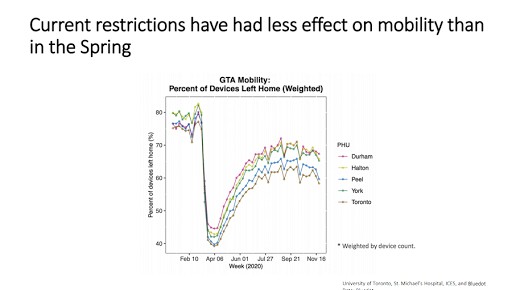
Cell-phone data show fewer people in Ontario are adhering to restrictions compared to the spring.
Peel has been in lockdown since November 23, but for at least seven weeks, the measures didn’t even put a dent in the case numbers, instead, they jumped dramatically around mid-December. Only now, after a stay-at-home-order was finally issued by the provincial government, and much stricter enforcement was introduced by most large municipalities, are we seeing a decline in cases over the last week.
Ottawa, this week, had to introduce new rules for those recklessly flouting direction to cease all unnecessary foreign travel. An indication of how careless and indifferent many Canadians have been was the rash of politicians – who literally represent the will of the people – that decamped from their comfortable homes to head south and enjoy some sun over the holidays.
The apathy is understandable, even widely shared by many who were sympathetic toward those called out for their selfish behaviour, but it could prove devastating to all of us.
It is approaching a year since people’s lives have been defined by lockdowns, masks and mobility restrictions. From the initial shutdown in March, through a constantly changing set of public health measures, a new colour-coded reopening framework and more lockdowns, many have found themselves confused about what they can or cannot do.
Some have forgotten why they are doing it. Others are just frustrated because they want to live their ‘normal’ lives. Their minds are not concerned with the deadly possibility of contracting the novel coronavirus, they are growing restless for the only life they had ever known: backyard barbecues and get togethers with family and friends in the neighbourhood park, gatherings at places of worship where edifying spiritual kinship was cherished and all the random flights of fancy that remind we humans of our most fundamental need – to be free.
But for 201 families in Brampton there is absolutely no doubt about why their vacations and trips to the mall or the restaurant down the street were put on hold. Another 351 in Mississauga understand how critical it is right now to hold celebrations and classes virtually. Ten in Caledon don’t begrudge the need to wear a mask on public transit or even while skating at a public rink. They have all seen a loved one pay the ultimate price.
When the pandemic first struck Ontario and Doug Ford stood in front of the cameras at Queen’s Park, people were scared. The declaration of a state of emergency was issued against a backdrop of nightmarish stories flooding from Wuhan, Lombardy and New York. Scenes of refrigerated trucks turned into makeshift morgues outside Manhattan hospitals looked like something out of a Stephen King novel.
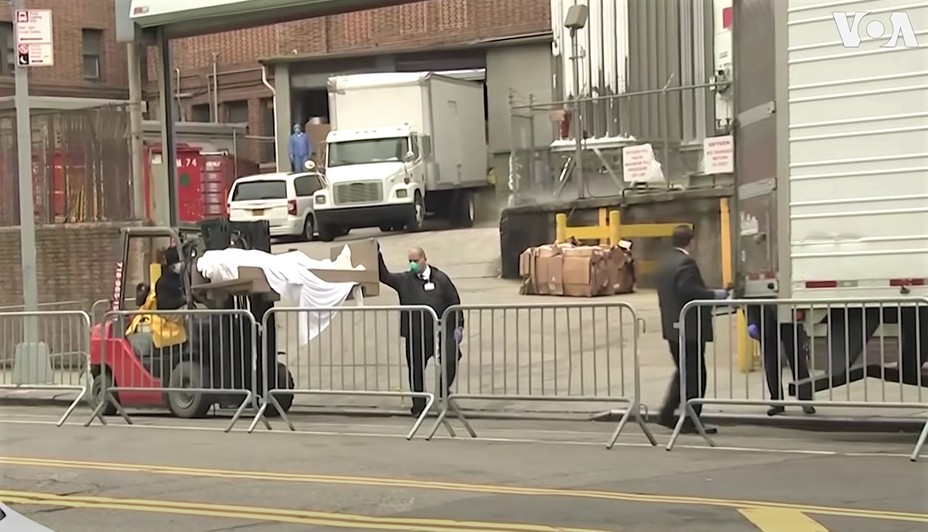
A forklift raises a dead body into the back of a refrigerated truck behind a New York City hospital in March.
We were collectively gripped. Terrified.
As anonymized cell phone data shared by the government show, the vast majority of people chose to listen and stay at home.
Ten months later, when the Province issued a delayed lockdown on Boxing Day, people seemed less diligent. A sense of complacency and fatigue had spread across Ontario, with parents exhausted from playing the role of teacher, friends desperately isolated and the idea of testing positive less of a terrifying unknown than it was in April.
Ontario slipped into a new normal where more people seemed unable to find the motivation to do their part, as they once did. The bungled response of the Ford government, and its complicity in showing Ontarians that public health was not the driver of many of its decisions, and non-decisions, contributed to the sense that citizens, just like the politicians who shamelessly took flight for their southern retreats, had sacrificed enough. COVID be damned!
Some have speculated that the arrival of vaccines, the silver bullet, has contributed to the carelessness – why should we bother fighting when the cavalry has arrived?
But as the CEO of Moderna, Stephane Bancel, said recently, COVID is here to stay and no vaccine, not even his, is the silver bullet.
“We are going to live with this virus forever,” he said two weeks ago during a global health conference.
Throughout December and January, hospital capacity records have been broken near daily and intensive care physicians have appeared on news shows pleading with the public to follow the rules. Some have heeded the calls, others have felt little white lies or even overt rule-bending aren’t a huge deal.
The Province’s stay-at-home-order and continued school shutdowns have seen cases begin to dip, but the threat of new fast-spreading variants means there is still a long way to go before even basic routines can return to normal.
In all of this, one problem in particular has been a key dilemma. The communications crisis facing Ontario is complex: how do you get people to start paying attention again when they have settled into their own apathetic reality?
“It’s really tied to something in health promotion theory which is called the Health Behaviour Model,” Dr. Lawrence Loh, Peel’s medical officer of health, told The Pointer. Loh was speaking generally on the communications challenges public health faces, drawing on his extensive experience and education. “[It] really starts with the idea of, ‘This matters to you’,” he added.
Without personalizing a message, Loh says other tactics can fall short.
He offered the example of drunk driving to show where highlighting a threat works and where it can fail. When messaging around drunk driving is purely about the legal consequences, viewers have to be shown a police presence in the communication to create a fear of the consequences – that enforcement will catch you if drivers try to take a risk that puts them and others in danger.
But this approach assumes people have to be forced to do the right thing, and those still willing to take the risk, will.
On the other hand, if drivers are shown why it’s their personal responsibility to keep themselves and others safe by operating a vehicle sober, some are more likely to make the right choices on their own, not because of the threat of consequences. But this approach relies on an ingrained, and reinforced, sense of responsibility. These types of personal commitments can be challenged during something like a protracted global pandemic that confronts people’s moral strength.
Winning hearts and minds reduces the need for heavy-handed enforcement, but it’s not easy.
Similar to traffic offences, total surveillance and enforcement of COVID-19 rules is impossible, meaning success relies on a sense of personal responsibility.
“If you’re just using fear, fear, fear as the overall adjunct for behaviour change, then you need to keep hitting them with it in order for it to actually have the effect,” Loh added. “Whereas the longer term, more sustainable way of doing things, is to try and bring them in to understand that this too impacts them.”
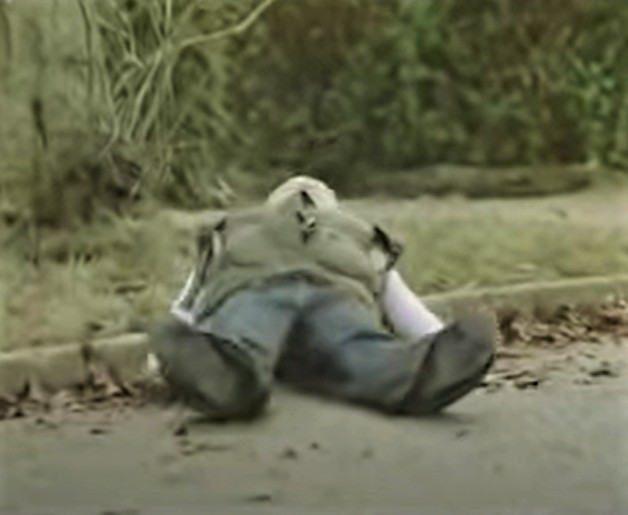
A British public awareness commercial shows an actor playing a young girl killed by a drunk driver.
A series of harrowing road-safety advertisements produced by the British Department of Transport under a campaign entitled THINK! viscerally drive home the point. In one spot — It’s 30 for a Reason — the body of a dead child reanimates, explaining anyone hit driving at 30-miles-per-hour has an 80-percent chance of living, compared to an 80-percent chance of death at 40 miles per hour. Sound effects demonstrating the child’s bones repairing and a haunting voiceover put the public-service commercial squarely in the horror genre, leaving it playing on in the mind long after a viewing.
The invisible spread of COVID-19 makes this harder, but not impossible. Where a commercial can remind drivers of the shock, horror and guilt they could feel if they cause an accident, the spread of a virus due to careless behaviour is further removed from the harmful action. Images of the nightmare unfolding inside hospitals have been rare in news coverage and absent from advertising and public awareness campaigns.
In the short term, fear did motivate people to follow the rules in the spring. The advent of an unknown virus (spread by others, widely dreaded and known to be potentially deadly) checked a series of boxes for Peter Sandman’s Rules of Risk Communication. The theory, referenced by Loh, can be used to predict how scared of a threat people are and if they may comply as a result.
“It was really that fear that led to that significant compliance with the first wave,” Loh said. “Again, you can see that works in the short-run, but over the long-run, it really is about trying to get people to understand that there are things that are within our grasp, within our control. You always expect a certain amount of non-compliance, I think that’s inherently part of public health practise.”
With the pandemic throwing out the rulebook at almost every opportunity, are there other ways to push compliance beyond good faith? Could some techniques act as a wake-up call?
Doctors and politicians have been trying to keep the public onside for months and it is clear some are wavering. The slew of foreign holidays taken by senior government figures, including some prominent healthcare leaders, shows fatigue can be about lying to oneself and not isolated to conspiracy theorists or anti-vaccine cliques.
Effective advertising can be used to communicate messages designed to change human behaviour. From pushing people to buy a product to public service announcements, there is an entire industry dedicated to understanding how people think, attempting to tap into that process and implant an idea. During the pandemic, many companies have found ways to include social distancing messaging in their campaigns, but few are creating promotional materials that make the public sit up straight.
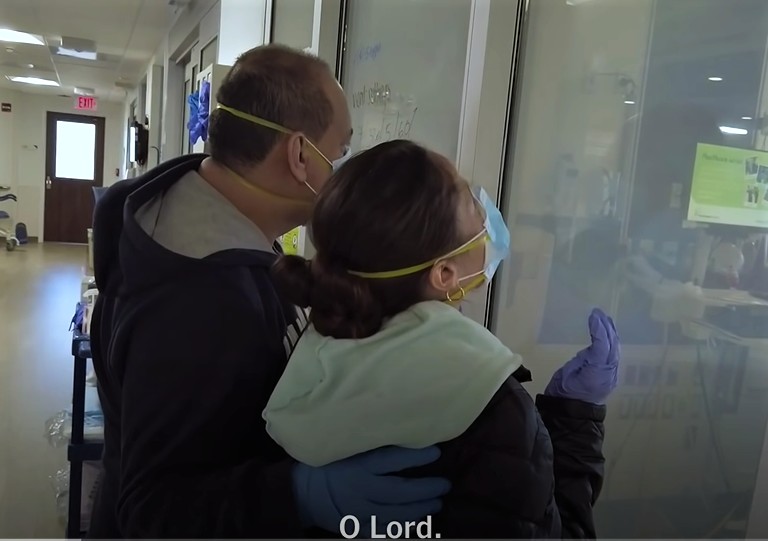
A harrowing New York Times video shows devastating hospital scenes of families, like this woman watching her grandmother suffer in isolation.
“If you think about what a government wants to do, it’s politics. Nobody wants to piss anyone off,” Ann Urban, a professor specializing in advertising at OCAD University (formerly known as the Ontario College of Art and Design) told The Pointer. “The best advertising, you want to narrow a select target group and then you want to drill deep on research… Governments are the exact opposite of that; they want to be all things to all people.”
Daegan McNeaney, a partner with Mississauga-based advertising firm Fresca, agreed that elected officials and bureaucrats tend to be cautious in how they advertise. “I think a lot of federal agencies, branches of government, avoid that because they don’t want to be too controversial in their approach,” he said. “I think there’s a lot of diplomacy at stake here, I don’t think people are willing to risk that, just based on my experience with some of my previous clientele.”
The advertisements most governments and public health bodies have produced during the pandemic have been sanitized and careful. They have reminded residents to distance, limit their trips and a few have warned viewers they too are susceptible to COVID.
“Some of the recurring themes when I was looking at these COVID ads had to do with educating people. It’s been a goddamn year, almost a year exactly. We really don’t know? There’s only three things: wash your hands, wear a mask, stay six feet away. So part of that question is: why are we still in the educational phase?” Urban asks. “People know, but they’re not doing it, that’s a whole other thing.”
Ahead of the Christmas period, the Government of Alberta broke with the stuffy traditions of its peers and created a COVID-19 campaign featuring a grotesque character known as Mr. COVID. The spots were met with mixed reactions and viewed hundreds of thousands of times. It approached the issue with levity, not severity, and confounded many. There was no denying it caused a stir.

"Mr. COVID" shocked many Albertans when the government released its ad campaign.
“The usual tone of messaging wasn't breaking through, or it was starting to be fatigued for this particular audience," Kurt Beaudin, ZGM Modern Marketing Partners, who made the series, told CTV. "So we wanted to try a different approach, a different angle with them to see if we could get a shift in their behavior."
Whether or not it changed behaviour is hard to say.
A lack of data or explanation around why people are more reluctant to follow public health guidelines during the most recent lockdown has frustrated marketing experts like Urban. It leaves them without the vital information they need to craft messages for particular audiences and coax a change in behaviour.
“As an advertiser, there’s a lack of transparency,” she said. “We have to know, why are people not complying because unless you know that answer, you don’t know what is effective advertising.”
In some ways, the nature of COVID-19 has tied the hands of public officials. A vocal group of disbelievers, rapidly spreading misinformation, competing interests of the business community and issues around privacy have all brought challenges. Loh cited the Vietnam War as an example of how officials have previously kept a focus on death tolls during a crisis that simply doesn’t work for COVID-19.
“Small towns all across America, at football games they’d say, ‘You have to stand for a moment of silence for our Vietnam dead’, and they’d basically read the names of servicemen and women who had passed away,” he explained. “You can’t do that with COVID... There is confidentiality and all these other parts, so by the very nature of the emergency, it does strip away a lot of typical messaging that might be used as part of a campaign to raise awareness. You can’t just go out there and list the names of all the dead — or at least I’m not able to.”
Equally, with governments under increasing pressure over their handling of the pandemic, there is little appetite at Queen’s Park to draw attention to the darker human cost. As Ontario’s second wave worsened in the late fall, Health Minister Christine Elliott, who daily tweets COVID-19 statistics, came under scrutiny from some like-minded journalists for refusing to include daily deaths in her tweets.
Even taking into account a government’s reputation, something is needed to punch through a wall of apathy.
“I think people need to see that shock, just like on cigarette cartons the warnings about cancer and things like that,” McNeaney said. “I think people need to see the reality of things, how people are being torn apart, how elderly folks cannot see their grandchildren and I think having that kind of approach would be pretty impactful, but it really is up to the client how they want to approach that.”
“It’s very polarizing,” Urban explained. “Shockvertising, the key thing it does is it gets your attention. What happens after that, well that’s just the art and science of advertising. If it’s done well, if it’s the right message for the right person, it could go either way.”
If governments continue to shy away from such an approach, other options exist to remind people of the scale of the tragedy. For centuries, war memorials and artistic creativity have represented human suffering.
Examples range from the cenotaphs that sit in most Canadian cities to the Hollocaust memorial in Berlin or Arlington Cemetery in Washington D.C.. Sculpture and art can convey a deeper and more resonant message than the demands of politicians or health officials.
“The unique thing about art is it can really speak to our subconscious … our human experience and have us connect to stories,” Maria Cheung, the founder and director of Taboo Health, told The Pointer. The group, which organized an online exhibition entitled Dying.dialogues on January 29 and 30, uses art to communicate difficult health messages and topics.
“It’s the expression of the experiences through art that is not direct, [not] should or shouldn’t or [telling] you to act in a certain way, it’s just consuming the expression and the experience,” she said. “Sometimes explaining it doesn’t do it, you have to do it. Art helps you actually feel the experience, not being told the experience.”
Last year, Taboo Health organized an installation (‘Constellations’ by Karen Oikonen and Kate Wilkes) to tell the story of how families experience death, documenting a range of different feelings into one exhibition. A series of hard-hitting questions, mounted on the wall, asked participants to use string to track their answers, slowly building a visual representation of the different ways that death can impact people.
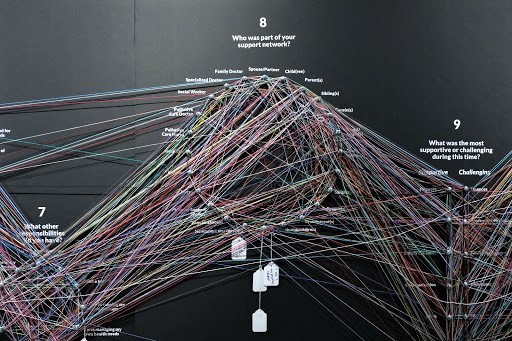
Art often helps people confront difficult issues that can otherwise be ignored.
Using art to share the painful experiences of those who have lost loved ones to COVID-19 can offer the opposite tactic to shockvertising. Rather than scaring or hammering a society into following the rules, it could play on a sense of personal responsibility to others in society.
“The approach with longer term behaviour change is [to] try to have people doing it, not because they’re worried about something that’s going to happen to them… but more about, ‘this matters to you’,” Loh said.
Email: [email protected]
Twitter: @isaaccallan
Tel: 647 561-4879
COVID-19 is impacting all Canadians. At a time when vital public information is needed by everyone, The Pointer has taken down our paywall on all stories relating to the pandemic and those of public interest to ensure every resident of Brampton and Mississauga has access to the facts. For those who are able, we encourage you to consider a subscription. This will help us report on important public interest issues the community needs to know about now more than ever. You can register for a 30-day free trial HERE. Thereafter, The Pointer will charge $10 a month and you can cancel any time right on the website. Thank you.
Submit a correction about this story


